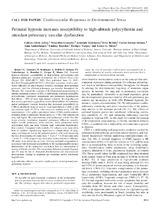Mostrar el registro sencillo del ítem
Perinatal hypoxia increases susceptibility to high-altitude polycythemia and attendant pulmonary vascular dysfunction
| dc.contributor.author | Julian, Colleen Glyde | |
| dc.contributor.author | Gonzales, Marcelino | |
| dc.contributor.author | Rodríguez, Armando | |
| dc.contributor.author | Bellido, Diva | |
| dc.contributor.author | Salinas Salmón, Carlos | |
| dc.contributor.author | Ladenburger, Anne | |
| dc.contributor.author | Reardon, Lindsay | |
| dc.contributor.author | Vargas, Enrique | |
| dc.contributor.author | Moore, Lorna G | |
| dc.date.accessioned | 2016-09-19T18:27:56Z | |
| dc.date.available | 2016-09-19T18:27:56Z | |
| dc.date.issued | 2015-04-27 | |
| dc.identifier.uri | http://repositorio.umsa.bo/xmlui/handle/123456789/7922 | |
| dc.description.abstract | Perinatal hypoxia increases susceptibility to high-altitude polycythemia and attendant pulmonary vascular dysfunction. Am J Physiol Heart Circ Physiol 309: H565–H573, 2015. First published June 19, 2015; doi:10.1152/ajpheart.00296.2015.—Perinatal exposures exert a profound influence on physiological function, including developmental processes vital for efficient pulmonary gas transfer throughout the lifespan. We extend the concept of developmental programming to chronic mountain sickness (CMS), a debilitating syndrome marked by polycythemia, ventilatory impairment, and pulmonary hypertension that affects 10% of male high-altitude residents. We hypothesized that adverse perinatal oxygenation caused abnormalities of ventilatory and/or pulmonary vascular function that increased susceptibility to CMS in adulthood. Subjects were 67 male high-altitude (3,600–4,100 m) residents aged 18–25 yr with excessive erythrocytosis (EE, Hb concentration 18.3 g/dl), a preclinical form of CMS, and 66 controls identified from a community-based survey (n 981). EE subjects not only had higher Hb concentrations and erythrocyte counts, but also lower alveolar ventilation, impaired pulmonary diffusion capacity, higher systolic pulmonary artery pressure, lower pulmonary artery acceleration time, and more frequent right ventricular hypertrophy, than controls. Compared with controls, EE subjects were more often born to mothers experiencing hypertensive complications of pregnancy and hypoxia during the perinatal period, with each increasing the risk of developing EE (odds ratio 5.25, P 0.05 and odds ratio 6.44, P 0.04, respectively) after other factors known to influence EE status were taken into account. Adverse perinatal oxygenation is associated with increased susceptibility to EE accompanied by modest abnormalities of the pulmonary circulation that are independent of increased blood viscosity. The association between perinatal hypoxia and EE may be due to disrupted alveolarization and microvascular development, leading to impaired gas exchange and/or pulmonary hypertension. | es_ES |
| dc.language.iso | en | es_ES |
| dc.publisher | Am J Physiol Heart Circ Physiol | es_ES |
| dc.subject | POLICITEMIA | es_ES |
| dc.subject | EXCESIVA ERYTROCITOSIS | es_ES |
| dc.subject | HIPOXIA | es_ES |
| dc.title | Perinatal hypoxia increases susceptibility to high-altitude polycythemia and attendant pulmonary vascular dysfunction | es_ES |
| dc.type | Article | es_ES |

